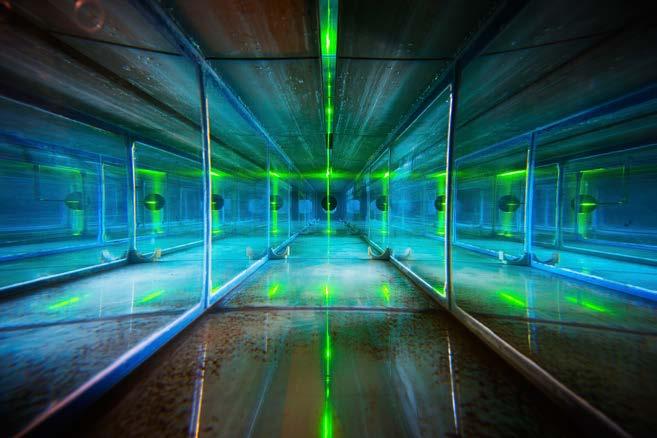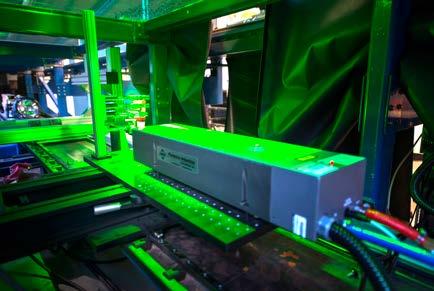
3 minute read
Unique facility for the study of fluid mechanics
Unique facility for the study of fluid dynamics
PhD candidate Jaime Wong peers into the towing tank.
Advertisement
Birds, insects and fish—past and present—have evolved to be remarkably efficient in moving and manoeuvring through air and water. The new OTTER (Optical Towing Tank for Energetics Research) lab, located in McLaughlin Hall, allows aerodynamics and hydrodynamics researchers to study, through hightech experiments, how flying creatures like seagulls and dragonflies move, accelerate, reverse direction and outmanoeuvre any aircraft designed by humans.
“Nature has optimized propulsion in air and water in many different ways,” says Dr. David Rival, OTTER lab supervisor and an assistant professor in the Queen’s Department of Mechanical and Materials Engineering. “Our research focuses on learning from nature to develop engineering solutions for contemporary societal problems, such as using wind energy more efficiently and making aerospace technology cleaner to reduce greenhouse gas emissions. Because of its unique construction, the optical towing tank allows us to test the aerodynamics of models at speeds and scales relevant to industrial applications.”
The OTTER facility is a 15-metre-long glass tank, holding approximately 15 tons of water. As fully submerged models— abstract representations of the animals— are towed rapidly through the tank, its high-speed lasers and cameras visualize, reconstruct and measure the flow fields around them in three dimensions. Through such experiments, the researchers can analyze the aerodynamic performance of these models in terms of propulsive efficiency and manoeuvrability, which provides new insights and ideas for “ ” In nature, seagulls and dragonflies have evolved much better ways of extracting the wind’s energy... improving the efficiency of, for instance, wind turbines and turbofan engines for the aerospace industry.
Dr. Rival’s group uses the OTTER lab as a tool to help improve the performance and longevity of wind turbines in gusty conditions. In nature, seagulls and dragonflies have evolved much better ways of extracting the wind’s energy for their benefit in unsteady airflows. The team runs experiments to simulate the responses of seagulls and scaled wind turbine models to such uneven flows. “By towing the model, we can create the effect of a gust hitting a turbine blade by accelerating the blade through the tank. We feed back what we learn into the design and siting of turbines to optimize their operation in an unsteady environment,” he explains.
The lab’s leading-edge experimental equipment is a huge hit with students like Jaime Wong, a PhD candidate in
Unique facility for the study of fluid dynamics
Inside the OTTER tank, lasers illuminate the flow field.


Dr. Rival’s lab. “Students see this giant facility, look at the cool things we’re doing and get drawn into research. I’m using the OTTER lab to study vortical structures in birds, insects and fish. It allows me to learn about the physics needed to design better AUVs (autonomous underwater vehicles) for search and rescue, or for any type of remote sensing technology in water or air,” says Wong.
Dr. Rival views the facility as fertile ground for experiential learning and discovery. “The OTTER lab excites students and draws them in because they can physically see the flow fields and learn by testing their ideas,” he says. “This kind of facility helps to attract postdoctoral researchers, top master’s and PhD students, and industry collaborators like Pratt & Whitney Canada and Bombardier Aerospace. It’s a unique place that promotes curiositydriven research and the exploration of new ideas, which wouldn’t happen as
The beam from the high-speed laser is modified by a series of mirrors and lenses to illuminate vortices generated by models passing in the OTTER above.
easily in another environment.”
Equipment/features list:

Four Photron SA4 high-speed cameras (for PIV and 4D-PTV) Photonics Industries DM40 Nd:YLF pulsed laser ATI Nano17 submersible force balance High-speed traverse
Main purpose: Aero/Hydrodynamics Principal investigator Dr. David Rival










